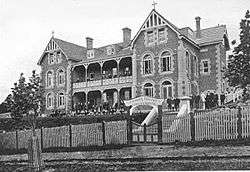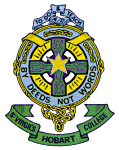St Virgil's College
| St Virgil's College | |
|---|---|
|
By Deeds not Words | |
| Location | |
|
Austins Ferry & Hobart, Tasmania Australia | |
| Coordinates | 42°46′30″S 147°15′05″E / 42.77500°S 147.25139°ECoordinates: 42°46′30″S 147°15′05″E / 42.77500°S 147.25139°E |
| Information | |
| Type | Private, Single-sex |
| Denomination | Roman Catholic, Christian Brothers |
| Established | 1911[1] |
| Principal | Damian Messer |
| Enrolment | ~750 (3–10)[2] |
| Colour(s) | Royal Blue, Green & Gold |
| Website | www.stvirgils.tas.edu.au |
St Virgil's College is a Roman Catholic, primary and secondary day school for boys, located over two campuses in Austins Ferry and Hobart, Tasmania, Australia.
Established in 1911 by the Congregation of Christian Brothers, the College has a non-selective enrolment policy and currently caters for approximately 680 students, from Years 3 to 10, with 120 at the junior campus and 480 at the senior campus.[2]
St Virgil's is affiliated with the Junior School Heads Association of Australia (JSHAA),[3] the Association of Heads of Independent Schools of Australia (AHISA),[4] and is a member of the Sports Association of Tasmanian Independent Schools (SATIS).
History

St Virgil's College was formally opened on 22 January 1911 by The Christian Brothers. Leo Doyle was the first student admitted to the College. At is foundation the College was a boarding school for boys located in Barrack Street, Hobart.[1] The boarding section of the College was closed in 1970 and since then St Virgil's College has been a day school only.
In 1962, another campus was opened in Austins Ferry,[1] offering junior secondary grades (Grades 7–9) on a riverside property of 30 hectares. In 1991, three Grade 10 streams were also added. 2012 marks the 50 year celebrations for the campus.
The Barrack Street campus then expanded for students from Grades 7–12 until 1994 when, under the Southern Secondary Schools Restructuring Plan, the campus no longer accepted enrolments for Grade 7. At the end of 1994, Grades 8, 11 and 12 ceased to run at the Barrack Street campus, and all secondary grades were moved to the Austins Ferry campus. This allowed Guilford Young College (Grades 11 and 12) to be established on the Barrack Street site. Grades 9 and 10 still ran in 1995, and only Grade 10 was offered in 1996.
After 1996, St Virgil's College ceased to operate any of its classes on the Barrack Street campus. From then on, Grades 7–10 were all taught at the Austins Ferry campus, and because of the discontinuation of Grades 11–12, many students moved on to the newly formed Guilford Young College for their pre-tertiary years.
In August 1995, permission was granted for St Peter's School to become the St Virgil's College Junior School from 1996 onwards. The Junior School now accommodates boys from Grades 3–6 and operates on the old St Peter's School site in Patrick Street.
The current Principal of St Virgil's College is Mr. Damien Messer, who was appointed in 2010. In 2009, Mr Christopher D. Smith left the college to carry out higher duties. Mr. Messer is now the full-time principal, with Mr Blizzard as the Vice-Principal, a former teacher of St Joseph's College in Geelong, Victoria.
Facilities
The College's buildings consist of superior science, music, art, sporting, computer, woodwork and metalwork, food technology and learning support facilities. Expansions to the library have currently begun construction in May 2009 and was completed in November 2009 Recent changes to the College's facilities include:
- The Joyce Performance Centre (2000) for stage shows and assemblies
- The Br Jack Higgins' Wing (2004) for more classrooms
- The alterations/expansion of the Edmund Rice Hall (2005–2006) to play sports
- The naming of "Our Lady of Perpetual Help" Chapel (2006) to pray
- St Virgils College Library (2009) for a wider selection of reading material for the students
- Centenary Centre (2011) to celebrate the 100th anniversary of the school
Curriculum
St Virgil's College offers a broad curriculum, with the areas of literacy and numeracy of high importance. Emphasis is also placed on the languages, science, social sciences and physical education. The College places the most emphasis on its teaching of religious education, which is central to every student's studies.
Co-curriculum
Sport
Much importance is placed on sport at St Virgil's College. All students are encouraged to participate in at least one sport during their time at the College.
The College has had much success on the sporting field throughout its history. Most recent is the College's domination of the Tasmanian State and Southern School's Athletics. The College's athletics team have won the SATIS (Sports Association of Tasmanian Independent Schools) Boy's junior title 10 years in a row, and the Southern SATIS title 10 years in a row as well.
Other sports on offer at St Virgil's include canoe polo, cross-country, cricket, football, hockey, rowing, soccer, swimming, tennis, touch football, water polo, basketball, rugby, badminton, squash, sailing and athletics.
Music
The College offers two teacher-coordinated stage bands accommodating players of different skill levels. St Virgil's also offers individual and small group instrumental tuition for those wishing to acquire the skills to excel further than a band setting can allow them. The College also has the facilities to accommodate students wishing to start their own rock band.
The St Virgil's College Senior Stage Band has won numerous awards for its efforts at various eisteddfods around Hobart. The Senior Band specialises in the areas of contemporary rock, jazz, blues and Latin music. The band often performs at school fairs, school productions and masses. In late 2005, the Senior Band, along with the jazz quartet, toured Melbourne, performing at various schools and other venues. It is currently organizing and arranging plans to go on a similar tour of Melbourne in 2007. The Senior Stage band has also taken part in many St Virgil's school musicals.
The band currently has between 10 and 15 members, and mainly features the trumpet, trombone and saxophone (alto, tenor and baritone), with a rhythm backing (drums, guitar and keyboard).
House system
As with most Australian schools, St Virgil's utilises a house system. The school houses are:
- Doyle — Blue
- Dwyer — Green
- Hessian (formerly Virgilian House) — Red
- Joyce (formerly College House) — Gold
Alumni
An Alumnus of St Virgil's College is known as an 'Old Virgilian' and may elect to join the school's alumni association, the Old Virgilians' Association. The Association was established in 1916 as a way for Old Virgilians to meet regularly and keep in touch with news about the College.[5] Some notable Old Virgilians include:
- Entertainment, media and the arts
- Anthony Ackroyd – comedian and writer
- Geoff "Jeff" Hook – Cartoonist[5]
- Don Sharp – film director[6]
- Tom Lewis – author, military historian and naval officer.
- Toby Leonard Moore – actor
- Peter Damian Williams – author and military historian.
- Military
- Major General Michael Crane AM – Commander of all Australian Forces in the Middle East area of operations (Iraq)[7]
- Captain Stephen (Sid) Dalton, RAN – former Commanding Officer of HMAS ONSLOW[8] and HMAS SHEEAN[9] a submarine named after Tasmanian war-hero Ordinary Seaman Edward 'Teddy'Sheean, former Captain SM and Chief of Staff Submarine Force Element Group October 2005 – December 2008 during a period of reforms driven by severe submarine personnel shortages[10] and minor author of Centre for Defence and Strategic Studies Shedden Paper[11]
- Colonel (ret.) Anthony McGee AM[12]
- Politics, public service and the law
- Richard Cogswell – Judge of the District Court of New South Wales and formerly NSW Crown Advocate[5]
- Jeff Coombes – academic[13]
- Henry Cosgrove AM – Judge of the Supreme Court of Tasmania[5]
- William Cox – Governor of Tasmania[5]
- Anthony Fletcher – Former member of the Legislative Council[5]
- Marek Havlat – academic[14]
- Peter Heerey – Justice of the Federal Court of Australia[5]
- Pierre Hutton – diplomat[15]
- Paul Lennon – 42nd Premier of Tasmania[5]
- Doug Lowe – 35th Premier of Tasmania[5]
- AG Ogilvie - 28th Premier of Tasmania [5]
- Kenneth Lowrie OBE – Former member of the Legislative Council and Glenorchy Alderman[5]
- Ashton Shirley – Former State Public Servant and Sportsman[5]
- Religion
- Rev. Adrian Doyle – Archbishop of Hobart[5]
- Rev. Prof. Michael Tate – Catholic priest and former Federal Justice Minister[5]
- Sport
- Scott Bowden Olympic mountain bike rider and road bike.
- Scott Brennan – Australian Rowing Olympic gold medallist and World Champion[5]
- Sean Clingeleffer – Cricketer; Tasmanian wicketkeeper[5]
- Michael Di Venuto – Tasmanian Tigers and Derbyshire County Cricketer
- Brodie Holland – AFL player for the Collingwood Football Club
- Simon Hollingsworth – 400 metre hurdles 2X Olympian and 3X Commonwealth Games representative; Rhodes Scholar[5]
- Jack Riewoldt – AFL player for the Richmond Football Club
- Ted Terry — outstanding schoolboy athlete, winner of the 1925 Burnie Gift, and AFL player for the St Kilda Football Club
- Tristan Thomas – Australian representative to the 2012 Olympics in Athletics[16]
- Sid Taberlay – Mountain Bike (Cross Country) Olympian
- Peter Toogood – Former Australian Amateur Golf Champion[5]
See also
References
- 1 2 3 "Our History". About St Virgil's. St Virgil's College. Retrieved 2008-02-12.
- 1 2 "St Virgil's College". Schools. Catholic Education Office Hobart. 2008. Retrieved 2008-02-12.
- ↑ "JSHAA Tasmanian Directory of Members". Tasmania Branch. Junior School Heads' Association of Australia. 2008. Retrieved 2008-02-12.
- ↑ "Tasmania". School Directory. Association of Heads of Independent Schools of Australia. 2008. Archived from the original on 19 July 2008. Retrieved 2008-02-12.
- 1 2 3 4 5 6 7 8 9 10 11 12 13 14 15 16 17 18 "Old Virgilians". About. St Virgil's College. Archived from the original on 2007-08-29. Retrieved 2008-02-12.
- ↑ Anthony Hayward, Don Sharp: Film director who made his mark with 'Kiss of the Vampire' from The Independent dated 29 December 2011, accessed 30 December 2011
- ↑ "Brigadier Michael Crane, AM". Operation Catalyst. Australian Government: Department of Defence. Archived from the original on 29 August 2008. Retrieved 2008-02-12.
- ↑ Up Periscope. "The Oberon Era". Submarine Association of Australia. Retrieved 11 April 2011.
- ↑ The Trade, December 2004. "HMAS SHEEAN". Royal Australian Navy. Department of Defence. Retrieved 11 April 2011.
- ↑ Dalton, Stephen (December 2008). "Changes Afoot" (PDF). The Trade: 31. Retrieved 11 April 2011.
- ↑ Dalton, Stephen. "Challenges to the nation-state in the Asia-Pacific: how will Australia adapt in the emerging era of the'Market-State'". Shedden Papers. Centre for Defence and Strategic Studies. Retrieved 11 April 2011.
- ↑ http://www.stvirgils.tas.edu.au/old-virgilians-association-ova/
- ↑ "University of Queensland Researchers". University of Queensland Australia. Retrieved 31 July 2014.
- ↑ "St John of God Pathology". St John of God Hospital, Murdoch. Retrieved 14 April 2011.
- ↑ Hutton, Claire (3 September 2014). "Skilled diplomat helped to build early links to Asian neighbours". The Sydney Morning Herald. Fairfax Media. Archived from the original on 6 September 2014.
- ↑ "London 2012 – Tristan Thomas Athlete Profile". Retrieved 4 August 2012.
